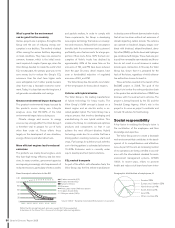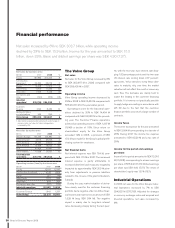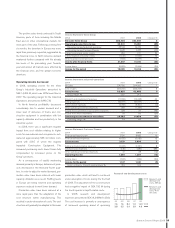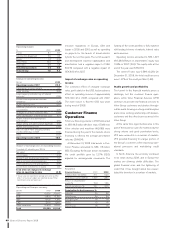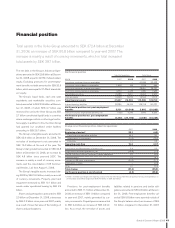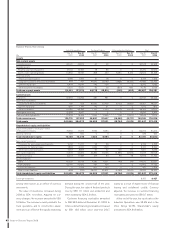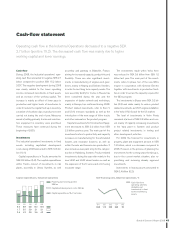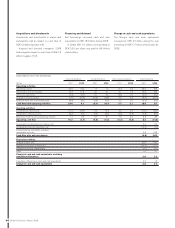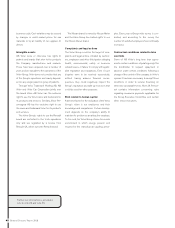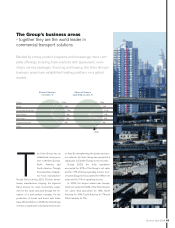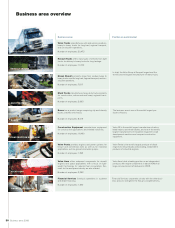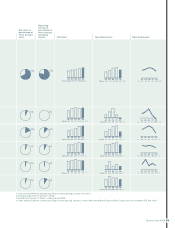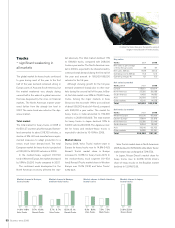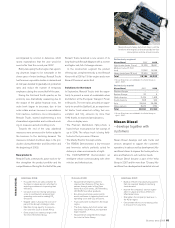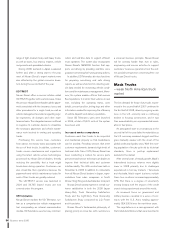Volvo 2008 Annual Report Download - page 50
Download and view the complete annual report
Please find page 50 of the 2008 Volvo annual report below. You can navigate through the pages in the report by either clicking on the pages listed below, or by using the keyword search tool below to find specific information within the annual report.
demand by the US Environmental Protection
Agency (EPA). The demand is a consequence
of dissenting opinions on whether an agree-
ment between EPA and Volvo Powertrain
regarding lower emitting engines also should
include engines sold by Volvo Penta.
The former labour agreement between
Mack Trucks, Inc. and the United Auto Workers
Union (“UAW”) expired on September 30,
2007. Since that time, the parties have been
operating under a mutually agreed upon day-
by-day extension of the previous agreement.
Negotiations on a new labor agreement are
ongoing. Both Mack Trucks, Inc. and the UAW
are parties to similar lawsuits fi led in the U.S
federal courts addressing the issue of retiree
healthcare benefi ts. Mack Trucks’ lawsuit, the
fi rst of the two lawsuits fi led, seeks a declaration
from the court that it is permitted to unilater-
ally amend the terms of the existing retiree
health care plan. The lawsuit fi led by the UAW
in response to the Mack lawsuit, seeks a ruling
from the court that the plan of benefi ts must
remain unchanged. On request by Mack, the
two cases have been consolidated. At present,
it is not possible to estimate the outcome of
the negotiations or the pending lawsuits, but
there is a risk that the outcome may have a
signifi cant negative effect on the consolidated
operating income.
Volvo verifi es annually, or more frequently if
necessary, the goodwill value of its business
areas for possible impairment. The size of the
overvalue differs between the business areas
and they are, to a varying degree, sensitive to
changes in the business environment.
The annual goodwill tests performed for all
business areas in the fourth quarter have not
resulted in any write-down. A continued fi nancial
crisis and volatility in interest and currency
rates could lead to indications of impairment
for some business areas in the forthcoming
periods, which would require goodwill valua-
tion tests to be performed for those areas as
long as indications remain.
General risks
External-related risk
The commercial vehicles industry
is cyclical
The Volvo Group’s markets have undergone
signifi cant changes in demand as the general
economic environment has fl uctuated. Invest-
ments in infrastructure, major industrial
projects, mining and housing construction all
impact the Group’s operations, since its prod-
ucts are central to these sectors. The cyclical
demand for the Group’s products makes the
fi nancial result of the operations dependable
on the Group's ability to react to changes in
demand, and in particular to the ability to adapt
production levels and production and operat-
ing expenses.
Intense competition
Continued consolidation in the industry is
expected to create fewer but stronger com-
petitors. Our major competitors are Daimler,
Paccar, Navistar, MAN, Scania, Caterpillar,
Komatsu, Cummins and Brunswick. In recent
years, new competitors have emerged in Asia,
particularly in China. These new competitors
are mainly active in their domestic markets,
but are expected to increase their presence in
other parts of the world.
Prices may change
The prices of commercial vehicles have, at
times, changed considerably in certain mar-
kets over a short period. This instability is
caused by several factors, such as short-term
variations in demand, shortages of certain
component products, uncertainty regarding
underlying economic conditions, changes in
import regulations, excess inventory and
increased competition. Overcapacity within
the industry can occur if there is a lack of
demand, potentially leading to increased price
pressure.
Extensive government regulation
Regulations regarding exhaust emission levels,
noise, safety and levels of pollutants from pro-
duction plants are extensive within the industry.
Most of the regulatory challenges regarding
products relate to reduced engine emissions.
The Volvo Group is a signifi cant player in the
commercial vehicle industry and one of the
world’s largest producer of heavy-duty diesel
engines. The product development capacity
within the Volvo Group is well consolidated to
be able to focus resources for research and
development to meet tougher emission regula-
tions. Future product regulations are well known,
and the product development strategy is well
tuned to the introduction of new regulations.
Currencies Interest rates in Sweden, Europe and the US, %
08
7.8
10.9
03
8.0
9.1
04
7.3
9.1
05
7.5
9.2
06
7.4
9.3
07
6.8
9.3
02
9.7
9.1
01
10.3
9.2
00
9.2
8.4
SEK/USD
SEK/EUR
SEK/100 JPY
8.66.7 6.5 6.7 5.8 5.87.37.98.2
Source: Reuters
Sweden
Europe
The U.S.
06
3.7
3.8
4.8
07
4.3
4.3
4.0
08
2.4
2.9
2.2
01
5.1
4.8
5.0
02
5.3
4.8
4.5
03
4.6
4.1
4.0
04
4.4
4.0
4.2
05
3.4
3.4
4.3
00
5.4
5.3
6.0
Government bonds, 10 year benchmarks
Source: Reuters
46 Board of Directors’ Report 2008


